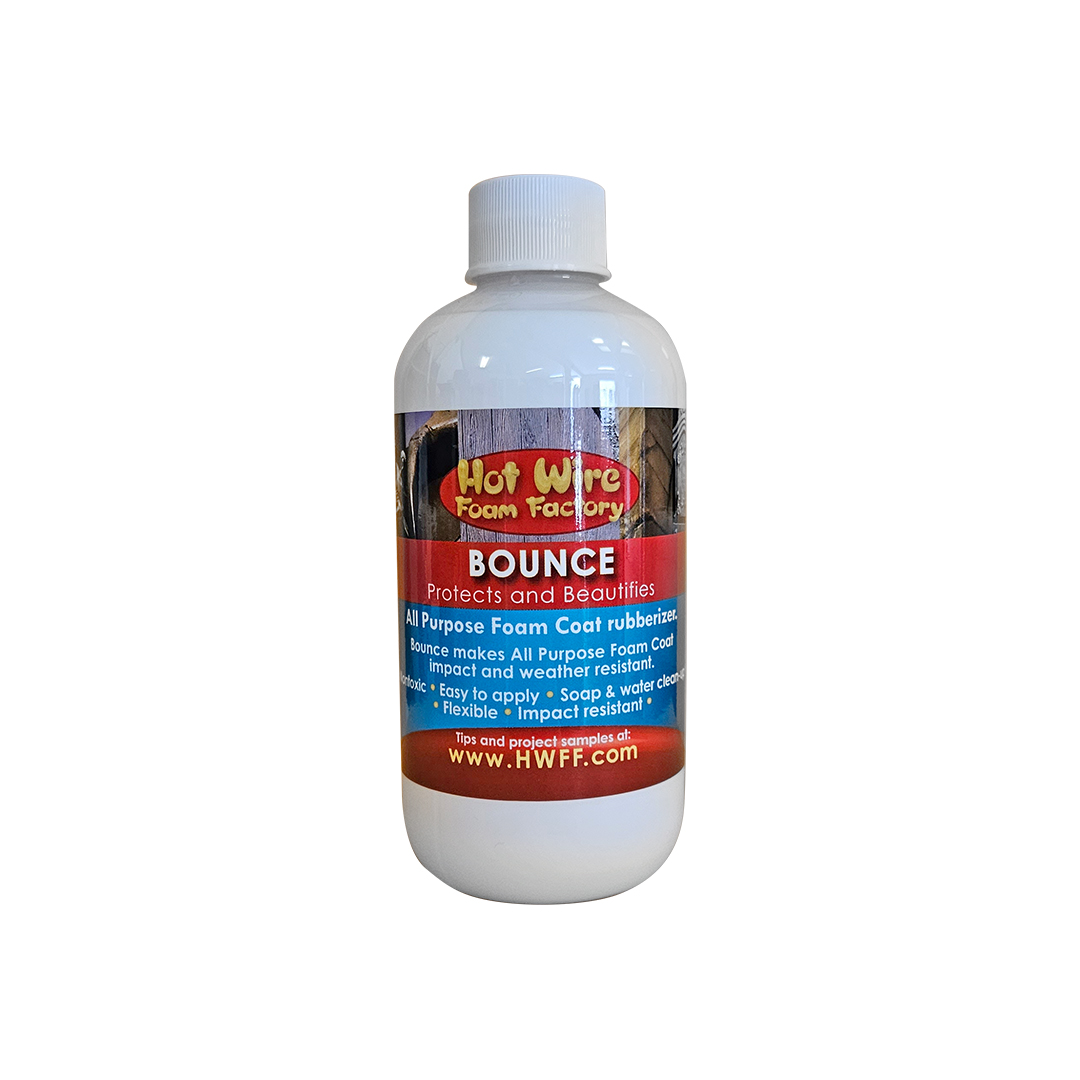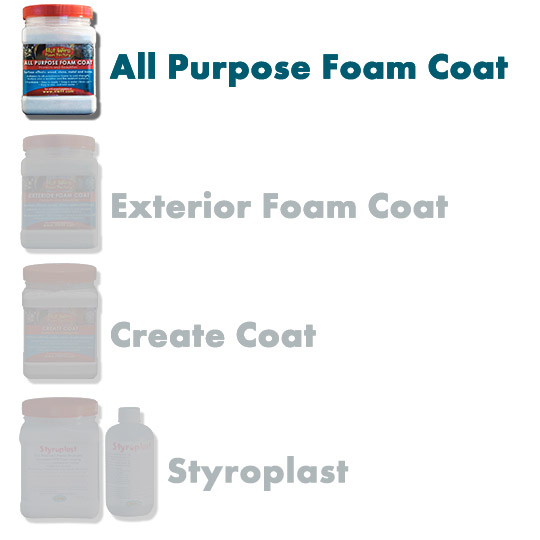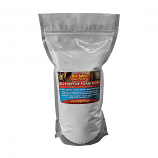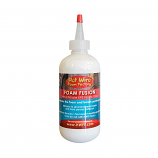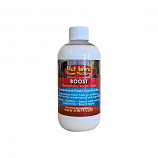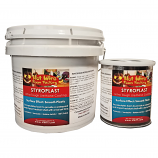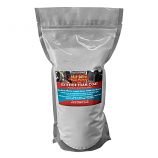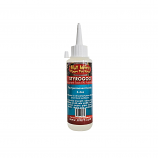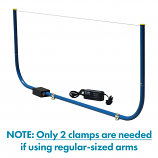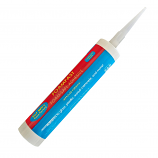Bounce RubberizerThe #1 Solution for Adding 'Flex' to Your Foam!Bounce RubberizerThe #1 Solution for Adding 'Flex' to Your Foam!A flexible, protective coating that resists cracking and chipping. Use Bounce on its own as a sealant or adhesive, or mix it with All Purpose Foam Coat for finishes ranging from flexible and crack-free to super-bouncy. Perfect for high‑traffic projects like playgrounds or walkways that normally see a lot of wear-and-tear.
⚠ Not for use with Exterior Foam Coat or Smooth Coat
Click here for Foam Coat Mixing Details and User Tips Click here for Foam Coating and Gluing Tips For a comparison of Foam Coats, click here To see foam projects made using this product, click here Instructions:
Mixing: Use Bounce with no added water for maximum flexibility. All Purpose Foam Coat comes out more flexible when no or less water is added to the Bounce. For a super rubbery coating, try a liquidy mixture of 9 parts Bounce to one part All Purpose Foam Coat, adding the powder to the Bounce, until the desired thickness is attained.
Can also be applied alone, or with just a little bit of Foam Coat to create a strong flexible paintable sealant. For a chip resistant coating, start with 1 part liquid to 1 part All Purpose Foam Coat, and thin or thicken as desired. Dilute the Bounce with water before mixing with Foam Coat to get a less flexible, super smooth, chip-resistant surface. Thin layers can be applied to vertical and inverted surfaces with little or no sagging. Applying: Fill holes with pasty mixture. To coat large areas, make a more liquidy mixture until thin enough to apply with a paint brush. May be applied as thick as 3/8 inch, but multiple coats are stronger. Looks like smooth stone when dry. Try texturing the surface before coating sets. Bounce is compatible with our Grit Texturizers. Can be smoothed while drying, but not sandable once dry. Set Time: Use within 15 minutes. Sets up in 30 minutes. Maximum bond and strength in 24 hours. Clean-Up: Immediately clean tools and brushes with soapy water. Finishing: Paint or stain as desired.
Videos:
Additional Info:WARRANTY: HWFF Inc./dba Hot Wire Foam Factory warrants this product to be of merchantable quality when used or applied in accordance with the instructions herein. The product is not warranted as suitable for any purpose or use other than the general purpose for which it is intended. Liability under this warranty is limited to the replacement of its product (as purchased) found to be defective, or at the shipping companies’ option, to refund the purchase price. In the event of a claim under this warranty, notice must be given to The Hot Wire Foam Factory in writing. This limited warranty is issued and accepted in lieu of all other express warranties and expressly excludes liability for consequential damages. MSDS available.
|
Is Foam Coat Fire Safe?
Our Foam Coats can be used inside. Not only are they fire-safe, but they also inhibit fires!
Fireproofing chemicals similar to those used on theater curtains have been sprayed on finished projects by several artists. In a normal room, this should satisfy the fire marshal. Fireproofing paints are also available.
Foam walls are commonly viewed as structural by fire marshals. A non-structural wall should receive the same fire rating as a curtain or piece of furniture. Fire ratings for structural walls are much stricter. Collapse occurs when a structural wall fails. In addition, internal walls are built to prevent fire spread.
Is Foam Coat Paintable?
Our Foam Coats can be painted. Once coated you can use almost any kind of paint. Make sure no foam is exposed, as some solvents found in some paints can dissolve it.
You can substitute up to 50% latex paint for water when mixing All Purpose Foam Coat. This will slow the drying time. You can mix water-based concrete pigments with Exterior and All Purpose Foam Coat. Then, if the foam coat chips it will be less noticeable.
Acrylic paints will mix fairly well with base foam coats, but when you add any additives like Bounce it doesn't take well.
Stainfast can be mixed with water based pigments and applied to Create Coat and Exterior Foam Coat to create a stone look. Stainfast also acts as a sealer.
How do I get the Foam Coat smooth?
If you tap on the Foam Coated object, the Foam Coat will momentarily liquify to smooth out the brush lines and other imperfections. You can also smooth it while it's setting with a metal trowel or putty knife.
Smooth Coat is smoother than Exterior or All Purpose Foam Coat and can be added as a last smoothing layer.
Use the little yellow 1-gallon paint spouts for troweling curved surfaces. They can be easily shaped for smoothing foam coat where you have contours. Also, the big yellow sponges that tile setters use help even out the coating and make it somewhat smooth.
How do I keep my Foam Coat from chipping?
For a much stronger coating use Mesh with any of our foam coats. Styroplast is the strongest and most chip-resistant coating we have. Adding Bounce to All Purpose Foam Coat makes it chip-resistant.
Although it helps to moisten the foam before applying, make sure the foam is not getting too wet. If it is cracking or chipping, you can apply a thicker coat, or try a 2nd layer with Boost or Bounce.
How much Foam Coat do I need?
With a 5lb jar, applying the foam coat 1/64"" thick will give you about 60 square feet of coverage. 1/16" thickness will give you 15 sq ft, and 1/4" will give you about 3.75 sq ft.
You can find a chart by clicking on the details section of either foam coats.
Is Foam Coat waterproof?
Smooth Coat and Exterior Foam Coat offer both weather and fire resistance. Many aquarium owners have had great results when using these in their tanks. Click below to see some examples.
We offer a foam-coat/stain system that is aquarium safe and will produce a beautiful natural stone or reef look. Exterior Foam Coat is applied over the foam shape. The coating is then sealed with StainFast, which is also a base for water-base stains. If you want more saturated colors, apply a thin coat of Create Coat over the Exterior Foam Coat, and apply the StainFast to that.
Can I add a second coat?
Adding a second coat of the foam coat is fine as long as the first coat has dried and adhered.
It is common to put on a first thin coat as a scratch coat which allows the second coat to adhere better. We actually recommend applying a scratch coat with Boost added to it when you coat XPS foam.
How do I apply Foam Coat?
Fill big cracks and holes by applying a pasty mixture with a trowel. If using extruded foam (ie Blueboard or Pinkboard) roughen the surface with coarse sandpaper. Apply with a paintbrush, stucco brush, trowel, or hopper gun.
- Use a thinned mixture to texture large areas.
- For best strength apply at least 1/4” (6mm) thick.
- Multiple coats may be applied.
- Brushing or spraying a thin first coat, called a scratch coat, will make the next coat much easier to apply.
- Try texturing surface as the coating sets.
Can I mix the foam coatings together?
We do not recommend mixing our foam coats together. Each has its own characteristics. The different ingredients might react with each other. We do have two fortifiers, Boost and Bounce, that can be mixed with our powdered foam coats. Bounce can only be mixed with All Purpose Foam Coat.
Do you ship Foam Coat internationally?
We can ship foam coat internationally. Although we do not offer any promotional shipping options on the 50lbs outside of the US due to high freight costs, rates are available on the checkout page.

